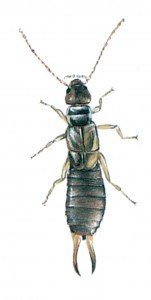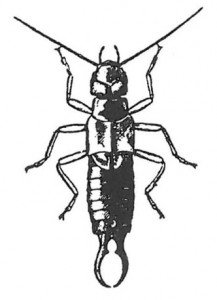

(The common Earwig)
Latin: Forficula auricularia.
Earwigs do not really belong in food storages. Yet it often happens that you find an earwig in food. The reason is that earwigs are very common animals in Northern Europe. They seek buildings, not because of the buildings themselves, but because they have narrow, dark hiding places. If they come into a store, there is always a risk that they are hiding in the goods or packaging. Earwigs are not synanthrope. They breed and overwinter outdoors. In September, they dig into the ground and go into hibernation. Often a female and a male overwinter together in a small hole in the ground. Early in the spring, the male is kicked out and the female decorates the cave as a breeding chamber. The approximately 30 eggs she lays hatch 5-8 weeks later. The offspring resemble the adults but are smaller and do not yet have wings. During the summer, the offspring matures. Earwigs are nocturnal animals, and many new insects are in need of locations, where they can sit dark and protected during the day.

At night they come out and eat. They are almost omnivorous with a menu that includes both live and dead plants, carrion, small insects and mites. Invasions of earwigs will take place in the late summer. To prevent earwigs from entering a building where you do not want them, you can take steps to remove their living spaces in the building’s immediate vicinity. In practice, this means that you should avoid tall grass, compost heaps and other garden waste near the building. Earwigs have wings, but the common earwig does not use them. It enters by climbing. Therefore, dusting a building’s base with an insect powder will keep creeping and crawling insects out. Door frames, cracks in windows and other cracks can be treated with poison lacquer.




